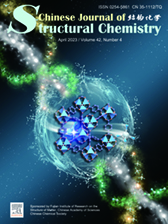
Cover Picture
Utilization of porous liquids for catalytic conversion
Yewei Ren, Guosheng Zhou, Ziyang Lu*
Submit a Manuscript
Utilization of porous liquids for catalytic conversion
Yewei Ren, Guosheng Zhou, Ziyang Lu*
Submit a Manuscript
A new indium-based MOF as the highly stable luminescent ultra-sensitive antibiotic detector
Wenjuan Ji*, Guojiao Wang, Bingqiang Wang, Bo Yan, Lulu Liu, Lu Xu, Tiantian Ma, Shuqin Yao, Yunlong Fu*, LingJuan Zhang*, Quanguo Zhai*
Chin. J. Struct. Chem., 2023, 42: 100062. DOI: 10.1016/j.cjsc.2023.100062
April 15, 2023
Metal-organic framework; Porous; Indium; Stability; Luminescent sensitive; Antibiotic detection
ABSTRACT
A novel luminescent double-interpenetrated metal-organic framework (MOF), named {[In6(O)3(BTB)4]·3H2O}n (1), is designed and synthesized using the tritopic linkers (1,3,5-tris(4-carboxyphenyl)benzene (H3BTB)) and tetranuclear clusters [In4O2(COO)8]. 1 features 3,8-connected dual-wall “cage-in-cage” and exhibits excellent chemical stability owing to its high connectivity and double-interpenetrated architectures. Moreover, it could rapidly detect thiamphenicol (THI), nitrofurazone (NFZ), and nitrofurantoin (NFT) antibiotics in N,N-dimethylformamide (DMF) with superior detection sensitivity (KSV) and low detection limits (LOD) of 4.52 × 103 M−1 and 348.6 ppm, 1.43 × 105 M−1 and 13.8 ppm, and 1.47 × 105 M−1 and 12.1 ppm for THI, NFZ, and NFT, respectively. Additionally, compound 1 exhibits good selectivity and recyclability. It is also effectively used to detect NFT in the milk sample. Furthermore, the mechanism of luminescence quenching was revealed through the experimental results and the density functional theory calculations. The occurrence of photo-induced electron transfer (PET) affects the fluorescence quenching effect of NFT and NFZ. The design of indium-based MOFs has the potential to detect antibiotic residues in food.







